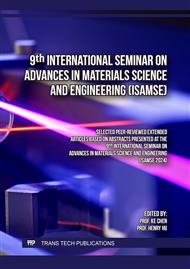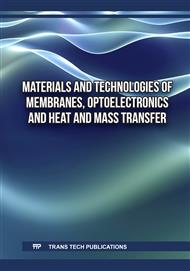[1]
K.S. Novoselov, A.K. Geim, S.V. Morozov, D. Jiang, et al., Electric Field Effect in Atomically Thin Carbon Films, J. American Association for the Advancement of Science. 5696 (2004).
DOI: 10.1126/science.1102896
Google Scholar
[2]
Z. Wu, Y. Lyu, Y. Zhang, R. Ding, et al., Large-scale growth of few-layer two-dimensional black phosphorus, J. Nature Materials. 209 (2021) 1203-1209.
DOI: 10.1038/s41563-021-01001-7
Google Scholar
[3]
Y. Liu, C. Zeng, J. Zhong, J. Ding, et al., Spintronics in Two-Dimensional Materials, J. Nano-Micro Letters. 121 (2020).
Google Scholar
[4]
S. Li, Y. Zhang and H. Huang, Black phosphorus-based heterostructures for photocatalysis and photoelectrochemical water splitting, J. Journal of Energy Chemistry. 67 (2022) 745-779.
DOI: 10.1016/j.jechem.2021.11.023
Google Scholar
[5]
L. Viscardi, K. Intonti, A. Kumar, E. Faella, et al., Black Phosphorus Nanosheets in Field Effect Transistors with Ni and NiCr Contacts, J. physica status solidi (b). 2609 (2023).
DOI: 10.1002/pssb.202370024
Google Scholar
[6]
J. Ni, H. Mi, P. Tan, X. An, et al., Lithography-free and high-efficiency preparation of black phosphorous devices by direct evaporation through shadow mask, J. Nanotechnology. 3322 (2022).
DOI: 10.1088/1361-6528/ac55d5
Google Scholar
[7]
Black Phosphorus: Degradation Mechanism, Passivation Method, and Application for In Situ Tissue Regeneration, J. Advanced Materials Interfaces. 723 (2020).
DOI: 10.1002/admi.202001538
Google Scholar
[8]
A. Favron, E. Gaufrès, F. Fossard, A.-L. Phaneuf-L'Heureux, et al., Photooxidation and quantum confinement effects in exfoliated black phosphorus, J. Nature Materials. 148 (2015) 826-832.
DOI: 10.1038/nmat4299
Google Scholar
[9]
H. Yang, DuMao, HongYingLiu, TaoWang, YananGuo, RuiZheng, YueYe, XinGao, JingGe, QiDeng, ChuyunCai, WeiweiZhang, XueaoQin, ShiqiaoChen, Wei, Native Oxide Seeded Spontaneous Integration of Dielectrics on Exfoliated Black Phosphorus, J. ACS applied materials & interfaces. 1221 (2020).
DOI: 10.1021/acsami.0c01161.s001
Google Scholar
[10]
L. Lei, S. Zhang, W. Lou, X. Zhang, et al., Protection mechanism of N,N-dimethylformamide on stability of few-layer black phosphorus, J. Frontiers in Environmental Science. 11 (2023).
DOI: 10.3389/fenvs.2023.1075842
Google Scholar
[11]
Q. Zhou, Q. Chen, Y. Tong and J. Wang, Light‐Induced Ambient Degradation of Few‐Layer Black Phosphorus: Mechanism and Protection, J. Angewandte Chemie International Edition. 5538 (2016) 11437-11441.
DOI: 10.1002/anie.201605168
Google Scholar
[12]
S.-Y. Lei, H.-Y. Shen, Y.-Y. Sun, N. Wan, et al., Enhancing the ambient stability of few-layer black phosphorus by surface modification, J. RSC Advances. 826 (2018) 14676-14683.
DOI: 10.1039/c8ra00560e
Google Scholar
[13]
M. Köpf, N. Eckstein, D. Pfister, C. Grotz, et al., Access and in situ growth of phosphorene-precursor black phosphorus, J. Journal of Crystal Growth. 405 (2014) 6-10.
DOI: 10.1016/j.jcrysgro.2014.07.029
Google Scholar



